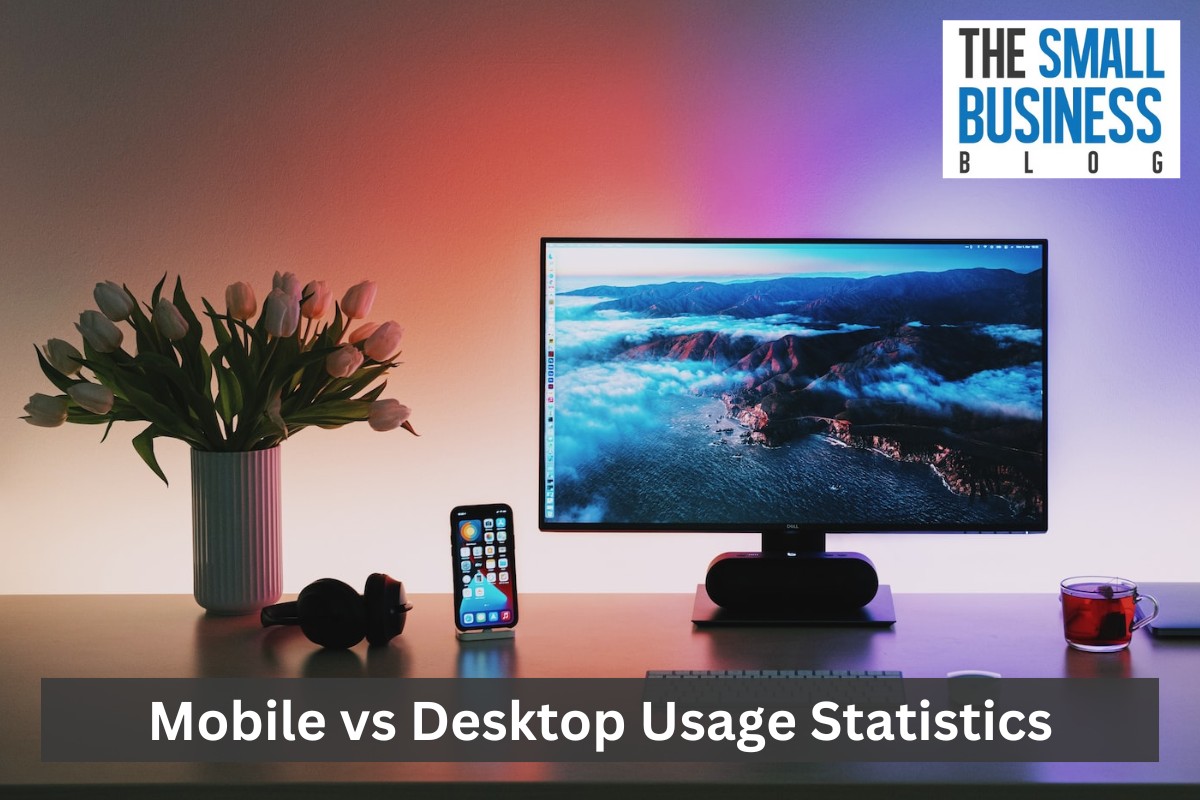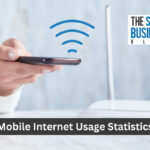The way we access and interact with online content has undergone a significant transformation.
With the rise of smartphones and the advancements in mobile technology, the debate between the world of mobile vs desktop usage statistics has gained momentum.
The dominance of desktops is now challenged by the rapid rise of mobile gadgets.
This article takes an objective look at mobile vs desktop usage statistics, shedding light on the trends that reveal our changing digital habits.
With each statistic, we get a clearer understanding of how we navigate the transformations that shape our preferences.
Let us delve into the numbers that underlie the mobile vs desktop usage debate and gain a new perspective on our digital choices.
Post Contents
- 1 Key Statistics
- 2 General Mobile vs Desktop Usage Statistics in 2024
- 2.1 1. Adults spent more than 5 hours per day engaged with their mobile phones
- 2.2 2. In North America, 83% of social media interactions are carried out through mobile devices
- 2.3 3. Mobile devices has a market share that’s more than 20% higher than desktop
- 2.4 4. Currently, 60% of worldwide internet traffic flows through mobile devices
- 2.5 5. As of 2023, smartphone subscriptions have surged past an astonishing 6.8 billion
- 2.6 6. Mobile devices has 49.78% of web visits while desktops has 50.22% share
- 2.7 7. 4.97 billion individuals across the globe are connecting to the internet using their mobile devices
- 2.8 8. Over the last 5 years, reliance on mobile devices has surged to 25% increase in usage compared to traditional desktops
- 2.9 9. Mobile phone usage marked a noteworthy increase of 24.5% in year 2021
- 2.10 10. Mobile devices make up 60.66% of internet traffic while desktop computers maintain a share of 37.08%
- 2.11 11. Samsung dominates mobile brands with 315 million units shipped globally
- 3 Flexibility and Accessibility of Mobile vs Desktop Statistics
- 3.1 12. The average individual taps, swipes, and interacts with their smartphone a minimum of 2,617 times daily
- 3.2 13. An average employee devotes approximately 56 minutes per day on their mobile phones
- 3.3 14. Mobile apps exhibit a conversion rate triple that of mobile websites and 1.5 times that of desktop sites
- 3.4 15. The global market for laptop is projected to expand to $7.2 billion from 2020 to 2024
- 4 Mobile vs Desktop Internet Usage Statistics
- 4.1 16. 63% of search engine searches within the United States are carried out using mobile phones
- 4.2 17. Fixed internet connections is 29.2 Mbps faster than mobile technologies
- 4.3 18. In the United States, 15% of internet users only use mobile devices
- 4.4 19. 25% of the time spent on digital media is dedicated to social media platforms
- 4.5 20. Younger individuals tend to rely on their smartphones for online activities rather than desktop
- 4.6 21. Tablet internet usage holds a worldwide market share of around 2.4%
- 4.7 22. By the year 2025, 72.6% of internet users are projected to rely exclusively on their smartphones to surf the web
- 4.8 23. Mobile users in the United States show an 11% higher likelihood of bouncing from websites or applications than in desktops
- 4.9 24. Desktop computers have an average upload speed of 60 Mbps while mobile devices are at 53 Mbps
- 5 Conclusion
Key Statistics
- Mobile devices surpass desktops with over 20% higher market share
- Currently, 60% of global internet traffic is through mobile
- 4.97 billion people worldwide connect to the internet via mobile devices
- Younger generations prefer smartphones over desktops for online tasks
- By 2025, 72.6% of users are expected to solely rely on smartphones for web access
- Over 5 years, mobile usage surged by 25%, outpacing traditional desktops
- A quarter of digital media time is spent on social media platforms
General Mobile vs Desktop Usage Statistics in 2024

1. Adults spent more than 5 hours per day engaged with their mobile phones
Mobile devices, especially smartphones, have become an indispensable part of our lives.
They provide instant access to information, social media, entertainment, and more, all within the palm of our hands.
Mobile vs desktop usage statistics from 2022 showcase adults in the U.S. allocated a substantial chunk of their daily routine to mobile device usage.
The portability of smartphones enables users to stay connected while on the move.
The availability of countless apps means that everything from shopping to accessing news is just a tap away.
Moreover, social media platforms have optimized their interfaces for mobile, making it the preferred choice for users to engage with their online communities.
(All Connect)
2. In North America, 83% of social media interactions are carried out through mobile devices
This trend shows a notable transition away from traditional desktop usage.
The convenience and accessibility offered by mobile devices have pushed people to the forefront of digital interactions.
The dominance of mobile usage in social media interactions has sparked a shift in user behavior and content consumption patterns.
Brief contents and posts that can be quickly digested are particularly well-suited for mobile consumption.
This has led to the rise of platforms like TikTok and Instagram Reels, which specialize in delivering short-form, visually appealing content.
(Zippia)
3. Mobile devices has a market share that’s more than 20% higher than desktop
According to recent data, mobile devices now command a market share that exceeds that of desktop computers by more than 20%.
This is a significant milestone, highlighting the transformation in the way we interact with technology and consume information.
The flexibility of smartphones, coupled with improved internet speeds and mobile-friendly website designs, has made mobile browsing a seamless experience.
From social media scrolling to online shopping, mobile devices offer a level of convenience that desktops can struggle to match.
(Janbask Digital Design)
4. Currently, 60% of worldwide internet traffic flows through mobile devices
Online behavior has drastically changed with the start of mobile internet technology in the early 21st century, marking a significant transition from the traditional desktop-centric usage.
Global internet traffic on mobile devices has surged by a staggering 573% in the last half-decade alone.
This surge in mobile internet usage is not just a passing trend, it’s a transformative phenomenon that has shown remarkable growth in recent years.
(Zippia)
5. As of 2023, smartphone subscriptions have surged past an astonishing 6.8 billion
With smartphones becoming more affordable and accessible, people from various corners of the globe have embraced the convenience and versatility they offer.
The rise of mobile devices has not only reshaped personal communication but has also revolutionized business strategies.
Companies have adapted to this trend by optimizing their websites and services for mobile interfaces, ensuring flawless user experiences regardless of the device being used.
However, despite the undeniable popularity of mobile devices, desktop usage still maintains its relevance.
Tasks that require complex details, extended periods of work, or a larger screen space naturally lean towards the desktop environment.
(Janbask Digital Design)
6. Mobile devices has 49.78% of web visits while desktops has 50.22% share
Mobile’s rise as a browsing tool is undeniable.
With nearly half of all web visits attributed to mobile devices, it’s evident that people find convenience in accessing the internet on-the-go.
The compact nature of smartphones and tablets offers unparalleled flexibility, allowing users to connect with the digital world wherever they are.
On the other hand, desktops haven’t been put to the shadows just yet.
Accounting for over half of web visits, these devices maintain their relevance by providing a larger screen, better multitasking capabilities, and a finer browsing experience for certain tasks.
Websites and applications must be designed with responsiveness in mind, catering to both mobile users looking for quick, bite-sized information and desktop users seeking in-depth exploration.
(Techjury)
7. 4.97 billion individuals across the globe are connecting to the internet using their mobile devices

Whether it’s checking emails, browsing social media, shopping online, or watching videos, mobile devices have revolutionized the way we interact with the digital world.
The convenience of mobile devices, coupled with the widespread availability of high-speed mobile networks, has led to the rapid adoption of mobile internet usage.
Websites and applications are now optimized for mobile responsiveness, ensuring a smooth user experience across different screen sizes.
Businesses have adapted their strategies to cater to mobile users, developing mobile apps and responsive websites to engage their audience effectively.
(Zippia)
8. Over the last 5 years, reliance on mobile devices has surged to 25% increase in usage compared to traditional desktops
Businesses and marketers have had to pivot their strategies to align with this mobile-centric reality.
From responsive websites to mobile apps, companies are channeling their efforts to enhance user experiences on smaller screens.
The emphasis on mobile search optimization and mobile-friendly content has become significant in maintaining a competitive edge in today’s market.
As technology continues to advance, it’s evident that the reliance on mobile devices will persist, if not intensify.
The convenience and flexibility offered by these devices are likely to continue reshaping consumer behavior, prompting further adaptations in how businesses and developers approach their digital offerings.
(Janbask Digital Design)
9. Mobile phone usage marked a noteworthy increase of 24.5% in year 2021
The 24.5% rise in mobile phone usage indicates a growing preference for quick accessibility.
This trend is particularly evident in activities like social media engagement, online shopping, and content consumption.
Nonetheless, desktop computers continue to serve a vital role in various tasks.
Striking the right balance and adapting digital offerings to cater to both platforms is key for staying relevant and meeting user expectations in today’s tech-driven world.
(Techjury)
10. Mobile devices make up 60.66% of internet traffic while desktop computers maintain a share of 37.08%
With over half of all internet traffic originating from mobile devices, it’s clear that they have become an integral part of modern online experiences.
However, desktop computers, while occupying a smaller slice of the traffic pie, still hold significance.
Their larger screens and enhanced processing power make them preferred tools for certain tasks like graphic design, video editing, and complex data analysis.
Additionally, the browsing experience on desktops can be more comfortable for longer sessions, allowing users to explore content in greater detail.
(Techjury)
11. Samsung dominates mobile brands with 315 million units shipped globally
Recent statistics from Counterpoint Research in 2020 shows how Samsung has consistently elevated its product capabilities and broadened its array of offerings, securing its position as a frontrunner in the smartphone sector.
Facilitating communication, providing entertainment, and serving as virtual storefronts for online shopping, their utility is undeniable.
Here is a list of the top 5 smartphone companies in the world:
- Samsung has 315 million units shipped worldwide
- Apple has 215 million units shipped worldwide
- Huwaei has 152 million units shipped worldwide
- Oppo has 111 million units shipped worldwide
- Vivo has 95 million units shipped worldwide
(Research)
Flexibility and Accessibility of Mobile vs Desktop Statistics
12. The average individual taps, swipes, and interacts with their smartphone a minimum of 2,617 times daily
This revelation exhibits the crucial role that mobile devices now play in our daily lives.
These pocket-sized gadgets have seamlessly integrated themselves into our routines, offering a convenient means to remain connected with friends, family, and the digital sphere.
What’s particularly interesting is the efficiency with which mobile devices fulfill our need for connectivity.
The frequent interaction we have with our phones signifies their ability to cater to our communication needs, from instant messaging to social media engagement.
This continuous connection not only maintains our bonds but also imparts a sense of security, the reassurance that we are always within reach, both socially and digitally.
(Research)
13. An average employee devotes approximately 56 minutes per day on their mobile phones
In a study by OfficeTeam’s staffing firm, the rise of mobile devices has transformed the workplace into a hub of diverse activities.
On average, an employee spends approximately 56 minutes per day, which accumulates to nearly 5 hours each week, to nonwork-related tasks on their mobile devices.
These activities range from checking social media platforms and instant messaging to browsing news and entertainment websites.
The portability and convenience of mobile devices make it easy for individuals to succumb to distractions.
The appeal of quick access to information and entertainment can lead to an inconsistent workflow.
While these devices offer flexibility, they also introduce challenges in maintaining focused attention on work-related tasks.
(Research)
14. Mobile apps exhibit a conversion rate triple that of mobile websites and 1.5 times that of desktop sites
This difference underlines the significance of mobile apps in driving successful outcomes in various domains, from e-commerce to content consumption.
Mobile websites, while convenient for easy browsing, lag behind mobile apps in terms of converting users into customers.
On the other hand, desktop sites, though favored for certain tasks requiring larger screens and more complex interactions, demonstrate a conversion rate lower than that of mobile apps.
This could be due to the differences in user behavior between desktop and mobile users, as well as the potentially less user-friendly interfaces of some desktop sites.
(Zippia)
15. The global market for laptop is projected to expand to $7.2 billion from 2020 to 2024

A recent report published by ResearchAndMarkets shows that the global laptop market is on a trajectory of remarkable growth.
Projections indicate that the market is set to expand to an impressive $7.2 billion from 2020 to 2024.
The ongoing debate about mobile devices versus desktop computers remains a subject of interest.
As smartphones become increasingly powerful and versatile, they have become the preferred choice for many users to access the internet.
However, the enduring significance of desktop usage cannot be underestimated.
Activities such as complex research, content creation, and data analysis are often better suited to the ergonomic comforts of desktop setups.
While mobile devices have become the choice for quick tasks, desktop computers continue to thrive as indispensable tools for tasks requiring higher processing power and a more extensive interface.
(ResearchAndMarkets)
Mobile vs Desktop Internet Usage Statistics
16. 63% of search engine searches within the United States are carried out using mobile phones
The choice between mobile and desktop devices for accessing information and conducting online activities has become a significant consideration.
63% of search engine searches within the United States are carried out using smartphones.
This statistic highlights the growing dominance of mobile devices in how people seek and consume information.
The portability of smartphones and tablets have propelled this trend, enabling users to access the web as quickly as possible.
(Zippia)
17. Fixed internet connections is 29.2 Mbps faster than mobile technologies
One critical factor that greatly influences mobile vs desktop usage decision is the internet connection speed.
According to the latest data, fixed internet connections have an average speed that is 29.2 Mbps faster than their mobile counterparts.
This disparity in speed has implications for user experience, impacting everything from web browsing to video streaming and online gaming.
Desktop devices, which are typically connected via fixed internet connections, offer users a distinct advantage in terms of speed.
This advantage becomes particularly obvious when engaging in activities that demand high data transfer rates, such as downloading large files or streaming high-definition content
(Techjury)
18. In the United States, 15% of internet users only use mobile devices
Internet usage is widespread in the United State that’s why understanding the dynamics between mobile and desktop usage statistics is crucial.
Recent data shows that approximately 15% of internet users in the U.S. solely rely on mobile phones to access the online world.
Mobile phones have become more than just communication tools, they are now our portals to information, entertainment, and social connections.
The convenience of carrying a powerful device in our pockets has pushed internet users to choose mobile as their primary means of access.
(Zippia)
19. 25% of the time spent on digital media is dedicated to social media platforms
Gone are the days when desktop computers reigned.
With the recent statistics, a quarter of all digital media consumption revolves around social media platforms, with a pronounced preference for mobile devices.
With the accessibility they provide, it’s no wonder that people find it more convenient to scroll through their social feeds while on the move.
The ease of whipping out a smartphone to catch up on the latest posts, share updates, or engage with content has solidified mobile’s dominance.
(All Connect)
20. Younger individuals tend to rely on their smartphones for online activities rather than desktop
The younger demographic values smooth multitasking and instant gratification.
Smartphones cater to these preferences by offering quick access to a multitude of apps and services at their fingertips.
Whether it’s checking social media updates, shopping, watching videos, or simply browsing the web, mobile devices provide a versatile platform for all these activities.
Below, you’ll see device usages from different ranges of age:
- 79% of ages 18-24 individuals use mobile, 19% use desktop, and 2% use tablet
- 68% of ages 25-34 individuals use mobile, 29% use desktop, and 3% use tablet
- 60% of ages 35-44 individuals use mobile, 37% use desktop, and 3% use tablet
- 54% of ages 45-54 individuals use mobile, 41% use desktop, and 5% use tablet
- 41% of ages 55-64 individuals use mobile, 53% use desktop, and 6% use tablet
- 30% of ages 65-74 individuals use mobile, 62% use desktop, and 7% use tablet
- 15% of ages 75+ individuals use mobile, 76% use desktop, and 8% use tablet
(Zippia)
21. Tablet internet usage holds a worldwide market share of around 2.4%

Tablets offer a middle ground between smartphones and desktops, providing larger screens than phones while retaining some level of portability.
Despite their unique advantages, tablets have yet to capture a significant portion of the internet usage market.
Several factors contribute to the differences in mobile, desktop, and tablet internet usage.
The flexibility of smartphones and their role as an all-in-one communication and entertainment device has driven mobile usage.
On the other hand, the familiarity of traditional desktop setups keeps them relevant, especially in professional and academic settings.
(Zippia)
22. By the year 2025, 72.6% of internet users are projected to rely exclusively on their smartphones to surf the web
To put this into perspective, this percentage translates to nearly 3.7 billion individuals globally.
This surge in mobile-exclusive internet usage displays more than just a change in gadgets, it signifies a fundamental change in how we interact with the online world.
The rapid adoption of mobile devices is reshaping various aspects of our digital experiences.
Websites and online platforms are being designed with mobile responsiveness in mind, ensuring consistent navigation and readability on smaller screens.
As we move towards 2025, the world will witness an unprecedented number of individuals relying solely on their smartphones to access the web.
This change underscores the need for businesses, developers, and content creators to adapt to this evolving landscape, ensuring that their digital offerings remain accessible and engaging across all devices.
(All Connect)
23. Mobile users in the United States show an 11% higher likelihood of bouncing from websites or applications than in desktops
The bounce rate, a metric that measures the percentage of visitors who navigate away from a site after viewing only one page, provides crucial insights into user engagement.
The 11% disparity in bounce rates between mobile and desktop users emphasizing a compelling difference in their online behavior.
Mobile devices, while offering exceptional convenience and accessibility, come with limitations that can impact user engagement.
The smaller screen real estate, varied connectivity, and potential distractions contribute to a more fleeting user attention span.
As a result, users on mobile devices are prone to make quicker judgments about a website’s relevance and usability.
(Zippia)
24. Desktop computers have an average upload speed of 60 Mbps while mobile devices are at 53 Mbps
One significant aspect that sets these mobile and desktop technologies options apart is upload speed, a vital factor in our connected lives.
According to recent statistics, desktop computers enjoy an average upload speed of 60 Mbps.
In contrast, mobile devices offer an average upload speed of 35 Mbps. When it comes to upload speeds, desktop computers have an edge over mobile devices.
Several factors influence upload speeds, regardless of the device being used.
Internet service providers (ISPs), network congestion, type of connection (wired or wireless), and even the quality of hardware and software play roles in determining upload speeds.
Upload speeds impact how quickly you can share files, post content on social media, send emails with attachments, participate in video conferences, and upload videos to platforms like YouTube.
Faster upload speeds ensure a smoother and more efficient online experience.
(All Connect)
Conclusion
In technology, the debate between mobile vs desktop usage statistics continues to intrigue and inform.
From the rise of mobile-exclusive internet usage to the enduring significance of desktop environments for complex tasks, these statistics shed light on how we interact with the online world.
As smartphone subscriptions surge and mobile internet traffic skyrockets, businesses and developers must adapt their strategies to cater to both platforms.
While mobile devices offer unmatched convenience, accessibility, and portability, desktop computers excel in areas that demand larger screens, higher processing power, and a more extensive interface.
Behind the numbers lies a deeper narrative. Mobile devices have caused a transcendental transition in user behavior.
Short, bite-sized content thrives on mobile platforms, fueling the rise of platforms like TikTok and Instagram Reels.
Yet, desktops persist as sanctuaries for extended research, content creation, and data analysis, harnessing their raw processing power and ergonomic advantages.
The future lies in finding the answers within Mobile vs Desktop Usage Statistics, for it allows users to traverse between the quickness of mobile devices and the capabilities of desktops, enriching their digital journeys in this age of rapid technological transformation.






























